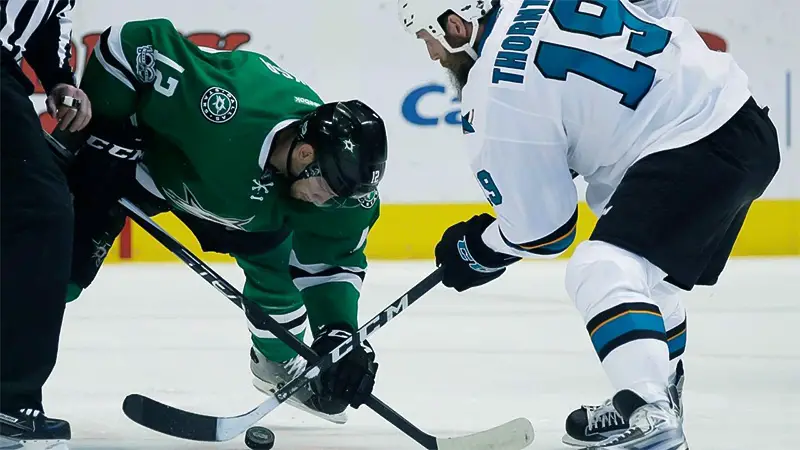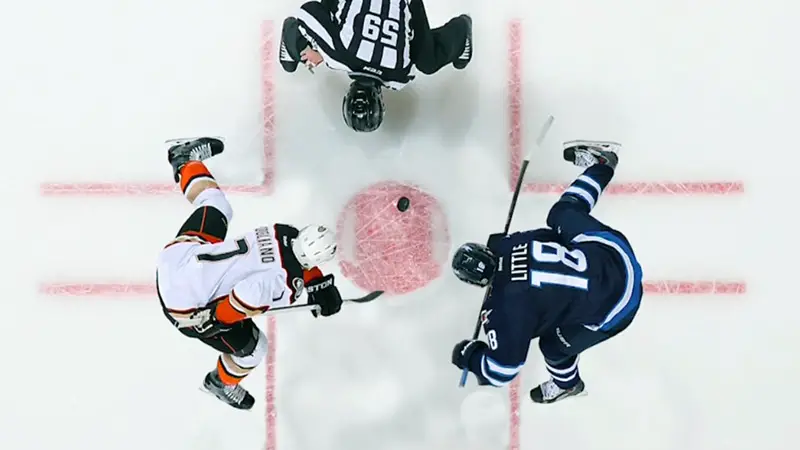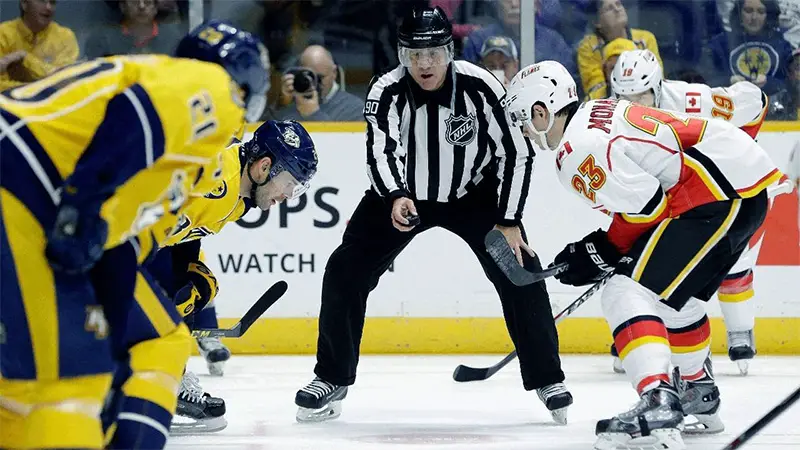Faceoffs in hockey are pivotal moments that can turn the tide of a game in an instant. These intense showdowns at the center ice circle determine which team gains possession of the puck and often set the stage.
However, it’s not uncommon to see players abruptly ejected from these crucial engagements, leaving fans, players, and coaches wondering why.
In this blog post, we delve into the reasons behind why do hockey players get kicked out of faceoffs?
From timing to stick positioning, faceoffs come with a strict set of rules enforced to maintain fairness and a level playing field.
Violations of these rules can lead to ejections, which can significantly impact a team’s performance and overall game dynamics.
These infractions and the strategies to avoid them are essential for both players and fans looking to appreciate the intricacies of this essential aspect of hockey. Stay focused.

What Is Faceoffs in Hockey?
Faceoffs in hockey are a critical aspect of the game, serving as a method to restart play after stoppages and determine which team gains possession of the puck.
They occur at the beginning of a period after a goal is scored, or when the puck goes out of play.
Two players, typically center, face each other in the circle marked on the ice, with their sticks on the ice and the curved part of the blade touching the surface.
The referee drops the puck between them, and the players use their sticks to try to gain control of it.
Faceoffs are not just about strength and timing but also strategy, as teams can employ different tactics to gain an advantage, such as trying to win the puck cleanly, tie up the opponent’s stick, or direct the puck to a specific teammate.
Winning faceoffs can lead to offensive opportunities or help prevent the opposing team from gaining control, making them a crucial element in the game of hockey.
The Rules of Faceoffs in Hockey

The rules of faceoffs in hockey are essential to ensure fair play and determine which team gains possession of the puck. Here are the key rules governing faceoffs:
Placement of Players
Each team designates a player to take the faceoff. These players usually line up in the marked faceoff circle corresponding to their offensive or defensive zone.
Positioning
Players must stand squarely facing the opponent’s end of the rink, with their skates behind the restraining lines of the faceoff circle.
Sticks
Players must keep their sticks on the ice, touching the surface inside the marked area of the faceoff circle. The curved part of the blade must be within the boundaries of the circle.
No Encroachment
Other players from both teams must be positioned outside the faceoff circle and maintain a distance of at least 15 feet (4.5 meters) from the faceoff dot until the puck is dropped.
Timing
The puck is dropped by the referee once both players are ready. Players must not anticipate the drop, as this is considered a violation.
Winning the Faceoff
The player who gains possession of the puck by legally using their stick to make contact with it first is considered the winner of the faceoff.
Winning the faceoff often means gaining a strategic advantage for the player’s team.
Infractions
Common infractions during faceoffs include encroachment by players not taking the faceoff, stick or body fouls, and delaying the drop. These violations can result in penalties or removal from the faceoff circle.
Restarting Play
Faceoffs are used to restart play after stoppages, including the start of each period, after a goal is scored, or when the puck goes out of play.
Location
The specific location of the faceoff depends on the reason for the stoppage, such as a neutral-zone faceoff at center ice after a goal and a defensive-zone faceoff closer to the defending team’s goal after an icing call.
These rules ensure a fair and competitive environment for determining puck possession and are a fundamental aspect of the game of hockey.
Why Do Hockey Players Get Kicked Out of Faceoffs?
Hockey players can get kicked out of faceoffs for several reasons, primarily to ensure fair and consistent execution of this crucial aspect of the game. Here are some common reasons why players may be ejected from a faceoff:
Failure to Get Set in Position
Players have a limited amount of time, typically around 5 seconds, to get set in their designated positions within the faceoff circle once the referee is ready to drop the puck.
If they don’t do so promptly, they can be removed from the faceoff, ensuring that the faceoff takes place without any undue delay.
Premature Contact
Players are not allowed to make physical contact with their opponent or their opponent’s stick before the puck is dropped. This rule ensures that both players have an equal opportunity to win the faceoff.
Stick Violations
A player’s stick must be positioned correctly during the faceoff.
If any part of a player’s stick blade is not touching the ice surface within the boundaries of the faceoff circle when the puck is dropped, it can result in ejection from the faceoff.
Faceoff Violations
Any other infractions, such as encroachment by other players not involved in the faceoff, can also lead to players being removed from the faceoff circle.
These rules help maintain fairness and consistency in faceoffs, ensuring that neither team gains an unfair advantage.
When Do Hockey Players Get Kicked Out of Faceoffs?
Hockey players can get kicked out of faceoffs for several reasons, and these ejections typically occur when players violate specific faceoff rules or fail to adhere to the established procedures.
Here are the common situations in which hockey players may be ejected from faceoffs:
Failure to Get Set in Position
Players have a limited amount of time, usually around 5 seconds, to get into their designated faceoff positions within the circle once the referee is ready to drop the puck.
If a player doesn’t establish their position promptly, the referee may eject them from the faceoff.
Premature Contact
Players are not allowed to make physical contact with their opponent or their opponent’s stick before the puck is dropped. If a player initiates contact too early, they can be ejected from the faceoff.
Stick Violations
To ensure fairness, a player’s stick blade must be in contact with the ice within the boundaries of the faceoff circle when the puck is dropped.
If any part of the stick blade is not properly positioned, the player can be removed from the faceoff.
Encroachment
Players not involved in the faceoff must maintain a distance of at least 15 feet (4.5 meters) from the faceoff dot until the puck is dropped. If any player encroaches on this space, they can be ejected.
Delaying the Drop
Deliberately delaying the puck drop or attempting to deceive the opponent can result in ejection from the faceoff.
Ejections from faceoffs are enforced to maintain a fair and competitive environment during this critical aspect of the game.
Impact of Hockey Players Getting Kicked Out of Faceoffs
When hockey players are kicked out of faceoffs, it can have several impacts on the game:
Possession and Scoring Opportunities
Faceoffs are crucial for gaining puck possession, and winning one can lead to immediate scoring opportunities.
When a player is ejected, it may affect their team’s ability to gain possession and create offensive chances off the draw.
Defensive Vulnerabilities
Losing a faceoff can also have defensive consequences. If a team consistently loses faceoffs in their defensive zone, it puts more pressure on their goaltender and defense to prevent scoring chances by the opposing team.
Special Teams
Faceoffs play a significant role in special teams situations, such as power plays and penalty kills.
Winning a faceoff can help a team set up their power play or clear the puck while shorthanded. Ejections can disrupt the flow and strategy of these situations.
Player Strategy
Coaches often select specific players to take key faceoffs based on their skills and strengths.
When a player is ejected, the team may have to adjust its strategy and choose a different player to take the faceoff, which can impact the outcome.
Faceoff Statistics
Faceoff statistics are closely monitored in hockey, and players who excel at faceoffs can provide a significant advantage.
Ejections can influence a player’s faceoff winning percentage and, consequently, their reputation in this aspect of the game.
Game Momentum
Faceoffs can influence the overall flow and momentum of a game. Winning multiple faceoffs in a row can build momentum for a team, while frequent ejections can disrupt this momentum and slow down the game.
Players getting kicked out of faceoffs can impact the game by affecting possession, scoring opportunities, defensive stability, special teams, player strategy, and overall game momentum.
Strategies to Avoid Getting Kicked Out of Faceoffs

Avoiding ejection from faceoffs is crucial for maintaining a competitive advantage in hockey. Here are some strategies players can employ to minimize the risk of getting kicked out of faceoffs:
Focus on Timing
Pay close attention to the referee’s signals and be ready to establish your position as soon as the referee is set to drop the puck. Timing is critical to avoid ejection.
Maintain Stick Position
Keep your stick blade on the ice within the boundaries of the faceoff circle. Ensure that it is flat and touches the ice surface before the puck is dropped.
Avoid Premature Contact
Refrain from making any physical contact with your opponent or their stick before the puck is dropped. Be patient and wait for the official to release the puck.
Stay Within the Designated Area
Make sure you are within your designated faceoff position and do not encroach on the opponent’s side of the circle or cross over the restraining lines prematurely.
Communicate with Teammates
Coordinate with your teammates on the faceoff strategy. Ensure that everyone is aware of their roles, whether it’s winning the puck or providing support after the faceoff.
Study Opponents
Understand the tendencies of your opponent in the faceoff circle. Knowing their strengths and weaknesses can help you anticipate their actions.
Practice Technique
Work on your faceoff technique in practice, including your timing, hand-eye coordination, and puck control skills.
Use Legal Tactics
Within the rules, use legal tactics to gain an advantage. This might include angling your body or stick in a way that disrupts your opponent’s ability to win the puck cleanly.
Be Calm and Confident
Stay composed and confident during faceoffs. Nervousness or frustration can lead to mistakes and ejections.
Adapt to Referees
Different referees may have slightly different interpretations of faceoff rules. Pay attention to their tendencies and adjust your approach accordingly.
Learn From Ejections
If you do get ejected from a faceoff, use it as a learning opportunity. Analyze what went wrong and adjust your strategy for future faceoffs.
Remember that faceoffs are a critical aspect of the game, and mastering them can provide a significant advantage for your team.
FAQs
Why do hockey players often get kicked out of faceoffs?
Hockey players can get kicked out of faceoffs for infractions like not being set in position within 5 seconds, making premature contact with opponents, or failing to keep their stick blade completely on the ice when the puck is dropped.
Can getting ejected from a faceoff affect a team’s performance?
Yes, it can. Ejections can disrupt a team’s ability to gain puck possession, create scoring opportunities, or execute strategic plays, potentially impacting the game’s outcome.
Are faceoff ejections common in professional hockey?
Faceoff ejections are not uncommon in professional hockey, as referees rigorously enforce faceoff rules to ensure fair play and adherence to regulations.
How can players avoid getting kicked out of faceoffs?
Players can minimize ejections by focusing on timing, maintaining proper stick position, avoiding premature contact, and staying within their designated faceoff area, among other techniques.
Do faceoff ejections lead to penalties or warnings?
While faceoff ejections themselves do not result in penalties or warnings, repeated violations can lead to increased scrutiny from referees and potentially result in penalties for the team.
It’s essential for players to adhere to faceoff rules to avoid such consequences.
Wrapping Up
Faceoffs are more than just a routine part of hockey; they are dynamic battles of skill and strategy.
While it’s frustrating to see players kicked out of these crucial moments, the rules are in place to ensure fairness and maintain the integrity of the game.
Hockey players, from amateurs to professionals, must master the art of the faceoff to provide their teams with the best chance of success.
The next time you watch a hockey game and witness a player’s sudden ejection from a faceoff, you’ll have a better understanding of why it happened and the impact it can have on the game’s outcome. Best of luck.







Benjamin Kenyon